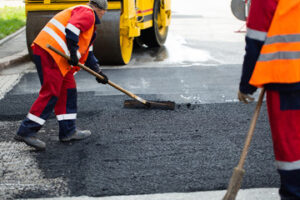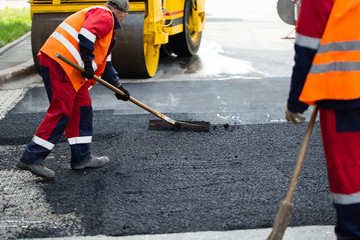Asphalt Paving is a popular choice for roadways and driveways. It is strong, durable, withstands freezing and thawing, and can be easily repaired.
A good asphalt contractor will have a portfolio of past jobs. Look for smooth transitions and consistent sizing. They should also follow drainage protocols, avoiding lingering pools of water that can damage the surface.

In a world that appears to be headed for nothing but throw-away everything, asphalt pavements designed and built to last indefinitely are an incredible achievement. They provide a smooth surface that improves vehicle ride quality, fuel consumption, and safety while significantly reducing maintenance costs and life-cycle costs. These enduring structures are a result of a simple process that involves applying three layers of the highest quality durable asphalt. The top layer acts as a protective shield against the harsh stresses and strains of daily traffic, while the middle layer and bottom layer add structural integrity. This allows the structures to withstand years of abuse without cracking and rutting.
This concept, known as Perpetual Pavement or Long-Life HMA pavements was formally recognized in 2000 by the Asphalt Pavement Alliance and includes the use of Mechanistic-Empirical design principles from surface to subgrade. The three asphalt pavement layers include a standard high-quality surface course, an intermediate layer, and a thicker fatigue resistant course. The top-down cracking and rutting that typically plagues traditional HMA pavements is confined to the surface layer, where it can be corrected by thorough periodic maintenance.
The intermediate and bottom layers are formulated to prevent bottom-up fatigue cracking and subgrade rutting by limiting the horizontal tensile strain at the bottom of the asphalt mix layer and vertical compressive strain on the top of the subgrade. These stress/strain thresholds must be kept below specific values, ensuring that deep structural distresses are not introduced. Additional asphalt thickness beyond what is required to keep these thresholds below critical levels is unnecessary.
The perpetual structure is a relatively inexpensive solution to the problem of long-term pavement performance, with maintenance costs limited to periodic milling and overlay of the surface layer. These procedures are easily completed overnight, with no impact on traffic flow. Since the underlying structural sections of the pavement are not affected, these maintenance operations can be performed at any time during the pavement’s service life, without compromising the longevity and serviceability of the structure. This approach translates to significant savings in agency and user time, money, materials, and energy.
Asphalt pavements need maintenance to help them withstand the elements and protect their structural integrity. It is important to inspect your asphalt for damages such as cracking, fading, depressions, and raveling. These damages should be repaired quickly to prevent them from getting worse.
In general, you should perform asphalt repairs at least once a year or more often if your asphalt gets heavy usage. The best time to repair asphalt is when it first begins showing signs of deterioration. This will minimize the damage and the costs of repairs.
It is important to use the proper asphalt for your needs. There are a variety of different asphalt types available to suit a wide range of applications and environments. Some of these include:
If you are unsure which type of asphalt to use, consider talking to a local asphalt professional. They will be able to recommend the right asphalt for your specific needs.
The right asphalt mix will provide the durability and flexibility you need. It will also meet the specifications of your project. You may also want to look into using warm mix asphalt. This is a specialized form of asphalt that offers similar performance to traditional hot mix asphalt, but it reduces emissions and energy consumption during manufacturing.
Regardless of which type of asphalt you choose, the best way to keep it in top condition is through regular maintenance. Inspect the asphalt for small cracks, oil spots, and other damages. These should be repaired promptly before they develop into their less desirable counterparts, potholes.
Other common problems that should be repaired immediately include depressions, rutting, edge cracking, and raveling. If you notice any of these issues, call a local asphalt contractor to have them fixed immediately.
When repairing asphalt, it is critical to make sure that the new surface is cool and allowed to set before being opened to traffic. This process is called curing and can take up to a year. The longer it takes for the asphalt to cure, the weaker it will be.
In addition to the above, there are a number of other asphalt maintenance services that should be performed regularly. These services include:
When it comes time to have your asphalt driveway, parking lot or road resurfaced or repaved, you want to work with a contractor who is honest and reliable. That’s why it is important to get a free estimate before choosing a contractor. Many contractors offer estimates over the phone, but a great contractor will come to your site to better understand what is needed. This is a good indicator that they have a strong sense of responsibility to their customers.
The estimate should include critical details such as the size of the project. This can be stated in a variety of ways, such as square footage, cubic yards or tons. A quality contractor will also state what type of asphalt mix will be used. This is important because the different types of asphalt have varying properties that can impact durability and life span.
Labor is another item that should be clearly described. Some companies use low-wage employees to reduce costs, while others are dedicated to hiring and retaining skilled workers that deserve fair compensation. It is important to compare the total labor hours in the estimates to make sure that you are not paying more than you should.
Other charges to consider are the cost of permits, soil removal or excavation and hot asphalt transportation fees. These can add up quickly, so you should ask for a breakdown of the expenses and how they will be calculated in your estimate.
Drainage is also an important factor to consider when obtaining your estimate. A well-draining pavement will last longer and will be less prone to premature damage from standing water. A reputable contractor will be able to identify drainage issues and suggest appropriate solutions.
It is also a good idea to request references from past clients and to drive by sites that have been recently repaved. This will give you a better feel for the workmanship and attention to detail that can be expected. It is also a good idea to speak with the paving contractor directly before making a decision, and to discuss how long the work will take and any potential inconveniences.
Whether it’s a small residential project or a large commercial paving job, customers want to work with a contractor who has the experience, skills, and reputation to get the job done right. Choosing a contractor with a good track record in the industry and a positive customer service reputation can help you feel confident that your asphalt paving project will be completed in an efficient manner.
Using social media to market your asphalt paving company is a great way to get your name out in the community and attract new clients. It is important to create a social media presence that is consistent with your brand and utilizes best practices. By implementing these marketing strategies, you can ensure that your target audience is seeing your content and responding positively to it.
When hiring a general asphalt paving contractor, you should always check to see that they are licensed and insured. If they are not, you should consider finding another contractor. Insurance is crucial in the paving industry, and you should ensure that the contractor has umbrella licensing policy, general liability, and workers’ compensation insurance, as well as insurance on all of their vehicles and paving equipment.
One of the best ways to show potential clients your paving company is to display online reviews and testimonials. Many people rely on online review platforms to find services and companies, and a paving company without an online footprint is essentially invisible to prospective clients. Online reputation management tools like Reputation Defender can help you collect and manage happy customer reviews, ensuring that one negative online review won’t deter clients from hiring your asphalt paving company.
Other methods of attracting customers to your asphalt paving business include paid advertising and local networking. Pay-per-click advertising allows you to target specific keywords and demographics to optimize your ad campaign, making it more likely that your ads are seen by the individuals who need your services. This method is especially useful for paving contractors, as it can help them reach the people who are most likely to hire them.



